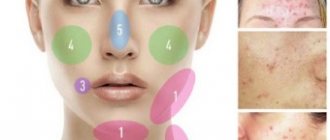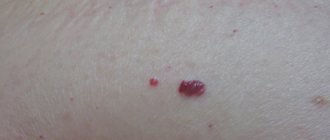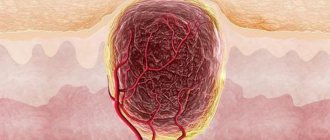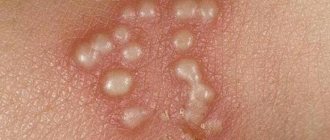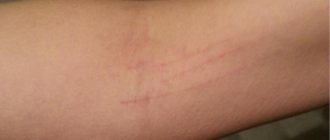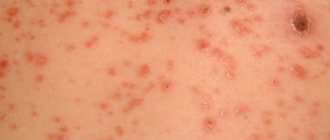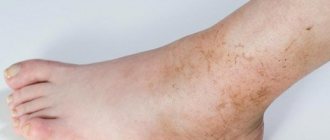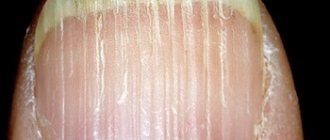What are warts?
Warts are benign formations on the skin or mucous membranes that are a manifestation of the papilloma virus. This infection is common to most people, the degree of manifestation depends on individual physiological characteristics. Usually papillomas do not cause discomfort unless they are painful.
As a rule, the papilloma virus develops latently in the human body, there are several reasons for this:
1) Reduced immunity.
2) Hormonal changes.
The incubation period can range from several weeks to 2-3 years. To investigate a specific subtype of the virus, you should donate blood for analysis or conduct a cytological examination.
Types of warts
1) Genital condyloma occurs on the mucous membranes of the genital organs.
2) Flat condyloma - also occurs on the genitals.
3) Filiform papilloma – elongated in shape.
4) A simple wart - a brown lump on the skin on different parts of the body (arms, legs, neck);
Spread of infection
Such warts are usually transmitted through personal contact. Common methods of spread are through common bathing areas. The infection enters the skin if it is damaged - cut, scratched, abraded or ulcerated in any way.
Infection can also occur if there are scratches, damage from nail treatments and shaving. This leads to the spread of the virus and the formation of warts in different parts of the body in the same person.
Treatment of toenails
Warts and pregnancy
During pregnancy, against the background of a decrease in general immunity, the papilloma virus may become more active. Warts can appear both on the skin and on the epithelial surfaces of the genital organs.
Causes of papillomas:
Warts may appear due to hormonal changes
1) Hormonal changes
2) Changes in the skin due to the weight gain of a pregnant woman (warts on the soles of the feet)
3) Diabetes mellitus can be a consequence of hormonal changes.
Simple warts on the skin are not dangerous during the period of bearing a child; it is impossible to infect a child with a papilloma infection during feeding, if the growths are present on the chest.
The main danger is condylomas, since they occur on the surfaces of the genitals. The growths reach relatively large sizes and can pose a threat at the time of childbirth (the presence of warts entails difficulties during childbirth; touching them increases the likelihood of the newborn being infected with this virus or the woman experiencing heavy internal bleeding).
If a child is infected with this virus, neoplasms may appear in the respiratory tract; This is the most negative scenario for transmission of infection. This can cause complications with the vocal cords and respiratory system.
The main causes of warts
Warts are caused by the activity of the human papillomavirus (officially called HPV). Most of humanity is a carrier of this virus, but not everyone shows its signs. The virus is transmitted quite easily - through contact with a carrier or through objects.
A woman can be infected long before pregnancy and be completely unaware of it until the main symptoms appear. During pregnancy, a woman's defenses (immunity) are significantly reduced, and her hormonal levels undergo major changes.
The combination of these two factors can easily activate the virus and cause unpleasant symptoms during pregnancy.
There is no need to panic ahead of time, since these growths are benign neoplasms of the skin. There are different types of HPV. Most often, two main types of warts appear during the gestational period:
- Common warts (also called papillomas) are dense, convex nodules with an uneven surface. As a rule, such warts do not exceed 3 mm in size. New growths are located on the hands and feet, but during pregnancy they can appear in other places: on the neck, face, armpits or chest.
- Genital warts are pink and white nodules of an elongated shape. Growths are localized around the anus and on the mucous tissues of the genital organs. The virus can appear as a single neoplasm, 1 mm in size, or as a whole cluster.
Common warts during pregnancy pose virtually no threat to the health of the mother and her unborn child. At the same time, the growths do not cause any pain. They are unpleasant only from a visual point of view and tend to multiply. Often, a large accumulation of warts in one place merges into one large plaque.
It’s another matter if genital warts appear in the genital area. Such growths often cause pain while walking and pose a great danger as they have a high degree of infection. Appearing on the mucous tissues of the genital organs, warts can interfere with the natural birth process. If they are not treated in time, the fetus is likely to get a viral infection.
What to do with warts
In general, formations can be removed in several ways:
- Cryodestruction: the use of liquid nitrogen to remove growths without damaging nearby skin;
- Thermocoagulation: Using high temperatures to remove a wart, which will fall off after a few days. This method must be used carefully, as there is a high risk of burning the surrounding tissue;
- Chemical destruction (treatment of formation with drugs that, due to their safety, can be used at home);
- Laser destruction (a rather expensive, but effective and accurate method of removal using a laser);
- Radiosurgery (use of high frequency waves, very expensive method).
- Surgery (removal with a scalpel is quite a painful procedure, and the likelihood of leaving scars is very high)
However, in order to comprehensively get rid of the papilloma virus, drug therapy is necessary, antiviral or anti-inflammatory drugs are prescribed. You need a doctor's consultation and a thorough examination.
Non-surgical treatment methods
You can remove a wart during pregnancy with the help of antiviral and cauterizing medications. Folk remedies are used as an auxiliary treatment measure. Medicines and home methods are selected taking into account pregnancy.
Pharmacy products
Interferon drugs are usually used as antiviral therapy. During pregnancy, such medications are used only in extreme cases, since taking pills can have a negative impact on the development of the unborn child.
A wart can be:
- Cauterize with iodine, brilliant green, hydrogen peroxide. These products are available in any home medicine cabinet. They need to be applied pointwise using a cotton swab, the procedure should be repeated 5 times a day for 5-10 days.
- Exfoliate with salicylic acid based products. This substance dissolves tumor tissue. You can use salicylic alcohol, as well as special patches (Salipod).
- Lubricate with antiviral agents for external use. These products include Oxolinic ointment and Aldara cream. Their use is safe for the fetus, since substances applied to the skin practically do not enter the bloodstream. Antiviral ointment can be used for 15-30 days; the exact duration of the course of treatment is determined by the doctor.
When warts appear en masse, drugs that enhance immunity are prescribed. Taking into account pregnancy, these can be plant extracts and dietary supplements, such as ginseng, eleutherococcus, echinacea.
Self-prescribing and taking immunity-boosting drugs during pregnancy is strictly prohibited.
Traditional methods
Cauterizing agents and compresses are used to treat growths. It is better to avoid using tinctures and decoctions internally, as they can have a negative effect on the fetus. In some cases, a child may develop an allergy to such medications after birth. Therefore, external remedies are suitable for treating growths during pregnancy:
- Cauterization with vinegar essence. Use a cotton swab to apply vinegar to the problem area every 2-3 hours. Lubricate the skin around with a rich cream or oil to avoid burns.
- Applying compresses with aloe and Kalanchoe juice. These plants contain antioxidants that increase local immunity against the virus.
- Lubricating warts with vegetable oils - castor oil, tea oil, fir oil. The procedure is carried out every 2-3 hours. When used in the genital area and on the face, dilute the active oil in half with olive or sunflower oil.
If a woman had allergic reactions before pregnancy, a preliminary test of the mixture should be done on the crook of her elbow. It can be used for treatment only if there is no redness or itching.
Warts in pregnant women: treatment and removal
According to doctors, the virus in its latent form is not a big threat to conceiving a child. Even if there are a few warts on the mother’s body, this is not dangerous. But, of course, it is advisable to undergo the necessary examinations.
Many people who are faced with the problem of papillomas ask: “Is it possible for pregnant women to remove warts?”
Doctors say that the issue of removing tumors in pregnant women should be treated with great attention. They advise to be sure to be examined before pregnancy. If this was not done, and the virus began to manifest itself sharply in the first months of pregnancy, but does not cause inconvenience, then removal of the formations should be postponed during pregnancy.
If the situation is critical and the papilloma virus needs to be treated, it is better to start therapy in the second or third trimester. This is the period when the child’s organs are already formed. Removal can be done using the same methods using Creon, laser, traditional surgery, etc. For the removal of genital warts, the most acceptable procedure can be considered radio wave coagulation together with the treatment of epithelial tissues with antiseptics.
You should carefully consider the choice of antiviral drugs for pregnant women due to side effects and contraindications. In addition, medications that increase general immunity are allowed.
Symptoms and signs
Most people with plantar warts complain of pain when walking. Pain in the feet can lead to altered walking posture, which over time causes back pain.
Foot pain
The disease is not inherited, but since HPV is very contagious, several family members usually consult a dermatologist at once.
People with eczema, low immunity, diabetes, AIDS, organ transplant recipients, those taking immunosuppressants, as well as patients with leukemia and lymphomas are especially susceptible to infection. About 50% of people who have a kidney transplant develop warts within five years.
Plantar warts feel hard to the touch and are located in pressure areas such as the heels or soles of the feet. The pressure causes them to flatten. Several warts may be combined into a mosaic group.
Unusual cases in the treatment of the virus
This option is possible when neoplasms appear intensively in the later stages, which can greatly complicate the birth process. If, after the examination, serious consequences are predicted, a special form of the papilloma virus is identified, in the most extreme case, termination of pregnancy and only subsequent therapy for the disease is possible. An oncologist should participate in consultations with the patient; the board of doctors decides on a cesarean section or termination of pregnancy and subsequent treatment measures.
You should carefully consider the choice of antiviral drugs for pregnant women due to side effects and contraindications
In some cases, patients say that warts go away on their own. Doctors attribute this to the fact that after childbirth, hormonal changes occur that affect changes in the general condition of a woman’s body. Immunity increases, the condition of the genital organs (in particular, the vagina and uterus) improves. Therefore the infection disappears.
To summarize, if you have warts, it is best to consult and be examined by a gynecologist before or during pregnancy. If warts on the skin do not cause discomfort and do not grow, then they do not pose any danger either during pregnancy or during childbirth. The situation is slightly different with genital warts (condylomas), which can complicate the process of childbirth. In this case, consultation with a gynecologist and oncologist is strictly necessary. In any case, an increase in the number of warts on the body is a reason to go to the clinic.
Delete or leave?
Is it possible to remove warts during pregnancy? It is possible, but not advisable. During this period, any medical procedures are carried out with caution; you need to be especially attentive to your health at the beginning and end of pregnancy. At this time, doctors refuse to remove papillomas. In addition, warts often appear due to unstable hormonal levels. As soon as a woman gives birth, the hormonal levels return to normal and the growths will disappear on their own. But if they increase in size, hurt, or change color, you should think about removal.
Cryotherapy can provoke premature birth, and the surgical method is stressful for the weakened body of a pregnant woman.
Even when doctors recommend surgery, radical methods are contraindicated during this period, that is, electrocoagulation and surgical removal are not practiced. Traditional methods should also be treated with extreme caution. They can cause allergies. In addition, some methods are dangerous for the child. For example, celandine juice is poisonous; it is not recommended for women in an interesting position.
Prevention measures
By knowing how and why warts appear, you can try to prevent their occurrence. What do we have to do?
- Get tough and eat right.
- Walk more in the fresh air and move.
- Do not neglect personal hygiene, wash your hands after visiting public places.
- When going to the pool, it is important to take your own rubber slippers with you. After bathing, they need to be treated with an antiseptic and dried.
- It is useful to dress according to the weather and the season. This will prevent increased sweating. It creates a favorable environment for the proliferation of the human papillomavirus.
- It is important to carry disposable disinfectant wipes or solutions with you everywhere.
- Before planning a pregnancy, you must be tested for HPV.
- When trying to minimize the possibility of warts, it is important to systematically strengthen the body, take vitamin complexes and follow the recommendations of the gynecologist leading the pregnancy.
Review of safe removal methods during pregnancy
If you decide to remove the growth, then the laser method and cryodestruction are considered a safe method of removal during pregnancy.
The laser method is based on the effect of a radiation flux on the cells of the body. Literally evaporation of cells occurs. Allows you to achieve high precision, forcing you to remove the formation layer by layer. The blood vessels are cauterized, which prevents bleeding. The laser is used on any part of the body.
The advantage of the method is the absence of scars. It is not possible to remove voluminous warts in one session; several sessions of the procedure are performed. In the postoperative period, you should take care of the wound. Disadvantages include possible changes in pigmentation at the surgical site.
Cryodestruction is popular as a way to get rid of warts during pregnancy. The essence of the technique comes down to the effect of the low temperature that liquid nitrogen has on the liquid inside and outside the cells. At low temperatures, water crystallizes and expands, which leads to the destruction of structures in cells at the tissue level. After peeling off, the wart softens and is eliminated on its own; in its place, a bubble with serous contents forms, then a crust forms. The period for rejection of the crust is 2-3 weeks. The method is painless and is used without anesthesia. Low risk of complications. As a result of this treatment, scars are not formed.
They try not to use the method on the face.
Contraindications for these methods include any inflammatory processes in the affected area, confirmation of cancer.
The anesthetic acts only within the tissues where it was injected. There is practically no absorption into the general bloodstream. There will be no harm to the child's health. Anesthesia is safe.
In case of malignant degeneration, the only acceptable method is surgical. Radioknife, like DEC, is not used.
